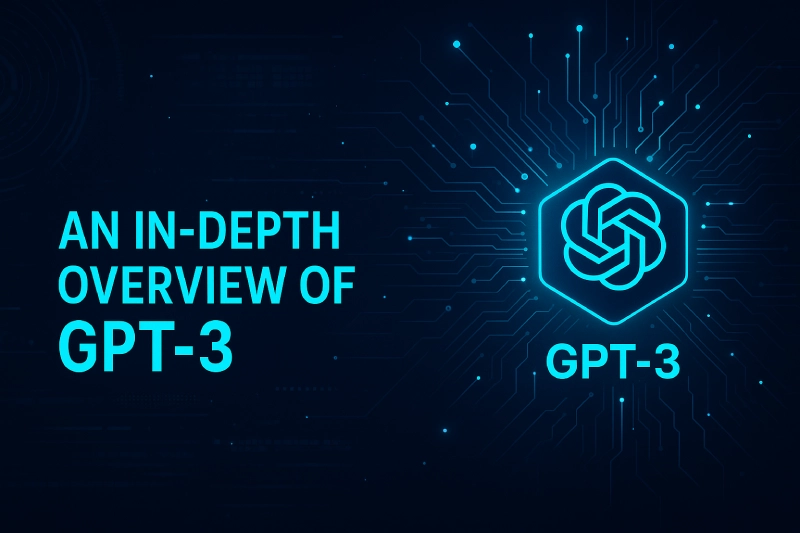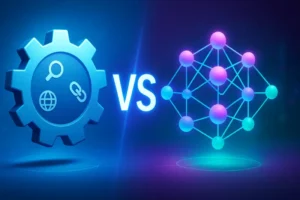GPT-3 arrived with a simple promise that felt big: give the model a short prompt, and it can often produce text that sounds like a person wrote it. Under the hood, it’s a transformer language model trained to predict the next token in a sequence. In practice, it kicked off a wave of creative experiments, a lot of hype, and a serious discussion about what large language models can and cannot do.
What GPT-3 Is
GPT-3 is an autoregressive transformer model trained on a broad text corpus to predict the next token. The full version contains 175 billion parameters. For context, GPT-2 used 1.5 billion. That leap in size brought stronger zero-shot and few-shot performance, letting people steer behavior through examples in the prompt instead of retraining the model.
In plain language, you write a few examples of the task inside your prompt. The model learns the pattern from those examples and continues in the same style.
Why It Felt Like A Breakthrough
Earlier systems needed task-specific fine-tuning. GPT-3 showed that you could keep a single model and just change the instructions. That shift unlocked a lot of prototyping. People tried summarizing articles, drafting emails from bullet points, writing short stories, answering trivia, and even formatting code snippets. None of this made the model perfect. It made it useful enough, often enough, to matter.
Early Demos That Shaped The Conversation
A few examples became reference points:
- Creative writing and style mimicry. Prompted correctly, GPT-3 produced poetry, parodies, and essays that captured tone better than earlier models. Some outputs were clunky. Some felt uncanny. Many were editable into something publishable with a human pass.
- Interactive fiction. Text adventure experiences like AI Dungeon switched from GPT-2 to GPT-3 and saw more coherent storylines. The model still took odd turns, but players noticed the difference in flow.
- Productivity experiments. Developers wired GPT-3 into spreadsheets to guess values from natural language. Others sketched UI components from text prompts, or asked the model to produce HTML and LaTeX fragments.
- Light coding helpers. Short SQL, simple regex, and rough code scaffolds started as demos before they became a normal part of many dev workflows.
These demos didn’t prove general intelligence. They showed that a large model with the right prompt can reduce first-draft friction.
How Prompting Actually Helps
Most real-world tasks use one of three patterns:
- Instruction prompting. A short directive such as “Summarize in three bullet points.”
- Few-shot prompting. A couple of input-output examples that establish format and tone.
- Chain-of-thought hints. Gentle guidance like “Think step by step” to improve intermediate reasoning.
The model doesn’t truly “understand” the way humans do. It follows statistical patterns from training. When the pattern in your prompt is clear, outputs improve. When the pattern is vague, the model guesses.
Where GPT-3 Struggles
Strengths and limits show up side by side:
- Factual accuracy. GPT-3 can sound confident while being wrong. Without grounding or retrieval, it hallucinates facts, dates, and citations.
- Reliability. Small prompt changes can swing results. Two runs with the same prompt can differ. Many workflows keep a human in the loop for review.
- Bias and safety. Outputs reflect patterns in the training data. Safety filters and careful prompting reduce risk but do not eliminate it.
- Multi-step reasoning. It can outline steps and follow simple logic, yet complex reasoning chains still misfire without explicit structure.
Understanding these limits isn’t a reason to ignore the model. It’s a reason to place it correctly in a process.
What Made It Different From GPT-2
Size alone doesn’t explain everything, but the jump from 1.5 billion to 175 billion parameters coincided with better performance on zero-shot and few-shot tasks. The API distribution also mattered. Making access simpler moved experimentation from research labs into everyday developer spaces. That changed the pace of iteration.
Real Use Cases That Stuck
- Draft acceleration. First drafts of emails, briefs, and outlines that humans refine.
- Summarization and expansion. Turning long text into short bullets, or bullets into paragraphs.
- Formatting tasks. Converting rough notes into cleaner structures such as tables, lists, or simple code blocks.
- Interface scaffolding. Generating starting points for UI copy, form labels, and helper text.
Each of these tasks benefits from a human editor. The model’s speed plus a person’s judgment is the practical pairing.
The Risk Conversation
Because GPT-3 can produce a lot of fluent text quickly, people worried about spam, misinformation, and malicious use. Early access came through an API with policies, content filters, and rate limits. Those guardrails reduced some risk while leaving room for research and prototypes.
From GPT-3 To What Came Next
The GPT-3 phase popularized prompt-based workflows. Later systems added instruction tuning and reinforcement learning from human feedback to follow directions more consistently. Retrieval and tool-use features increased factual grounding. The path from GPT-2 to GPT-3, and then onward, wasn’t a single jump. It was a sequence of small, practical shifts that made these models easier to use for non-experts.
Practical Tips If You’re Testing Today
- Start with clear prompts. Show the format you want. Give short, concrete examples.
- Constrain the task. Ask for one output at a time. Keep instructions tight.
- Review before use. Treat outputs as drafts. Check facts and links.
- Document what works. Save effective prompts and reuse them for consistency.
References
- Brown, T. B., Mann, B., Ryder, N. et al. Language Models are Few-Shot Learners. arXiv preprint arXiv:2005.14165 (2020).
- OpenAI. OpenAI API — official developer documentation.
- OpenAI. Better Language Models and Their Implications — blog post discussing GPT-2 and responsible release.
- Branwen, Gwern. GPT-3 Creative Writing Experiments — independent analysis and demos of GPT-3’s text generation.
- Mayne, Andrew. OpenAI API Alchemy: Summarization — early user demo of GPT-3’s summarization ability.
- Walton, Nick. AI Dungeon – Powered by GPT-3 — interactive fiction example demonstrating GPT-3 in games.
- Chopra, Paras. GPT-3 Search Engine Experiment — tweet thread summarizing prompt-based search experiments.
- GPT-3 Examples — ongoing community curation of early GPT-3 demos and applications.




